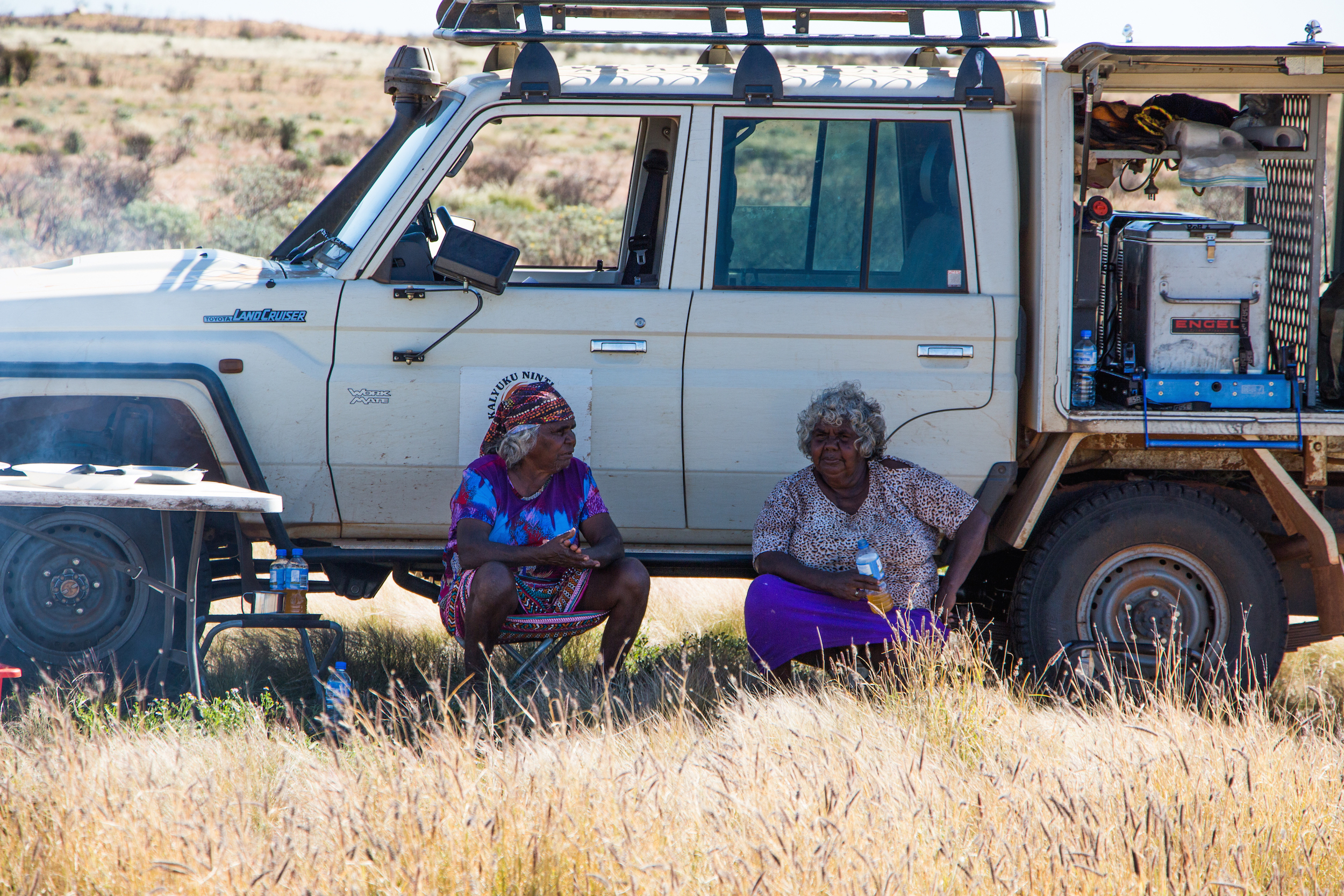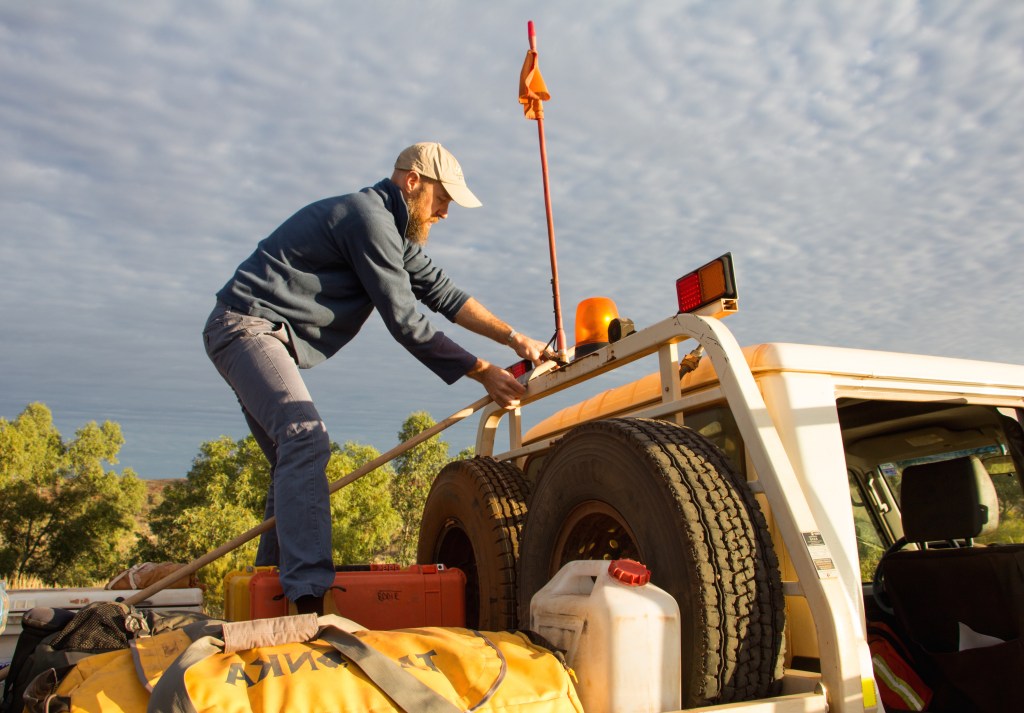Aboriginal and Torres Strait Islander viewers should use caution viewing this post, as it may contain mentions of deceased persons.
Field notes from the Australian desert: camels are exceedingly cheeky, bush tucker is delicious (if a bit awkward to eat), and desert waterholes are more frigid than refreshing.
In July, I joined Nature Conservancy scientist Eddie Game, University of Queensland student Chris O’Bryan, and several Martu elders for a science-packed adventure in the depths of the Western Australia’s deserts. Over the course of 5 days we deployed several remote-sensing data loggers in desert waterholes and had a cracking good time.
Here’s what a typical day is like for a field scientist working in the Red Center.
6:41 a.m. Sunrise in the desert. Steam rises off my tea as I sit on the table outside our house in Parnngurr Community — hundreds of kilometers from anywhere — watching the sun crest the horizon.
One of the two community camels saunters over, eyeing my mug greedily as he cranes his neck over the fence. When it becomes apparent that he’s not getting any tea, he throws a few cranky play-nips in my direction and then unleashes his pent-up rage on the gate, trying to unlock it with his slobbering lips. Thwarted again, he cruises onward to test his burglary skills on someone else’s yard.
7:37 a.m. Eddie, Chris and I pack up the ute for the day — careful to close the gate between each trip in case the camels return — loading in an esky filled with lunch supplies, pelican cases of gear, cameras, binoculars, and water. And our big stick.
8:45 a.m. We need to figure out where we’re going today. We sit in the shade outside of the Kanyirninpa Jukurrpa offices with Ngamaru, a Martu elder who’s advised us to put data loggers in two waterholes to the east of the community, Jiwal Jiwal and Jurrar.
Meanwhile, one of the camels is sticking its head through a nearby car window, trying to strip off electrical wire, while the other is standing nearby, doe-eyed, chewing on a book he fished out from someone’s trash.
Ray and Tina, the KJ ranger coordinators, discuss logistics and if it’s even possible to reach both of the waterholes in a day’s drive. Distances on the map are deceiving — the straight black lines running across the desert give no indication of the quality of the road — and the waterholes lie well away from any marked track.
Tina asks Ngamaru a final time if we’ll be able to reach both (and come back) in a day. “No, you’re alright,” she replies, smiling. “You’re not walking, you have Land Cruisers.”
9:34 a.m. We fill the car up with petrol and hit the road. Driving through town we pass Parnngurr’s main point of communication with the rest of the world: a rusty Telstra telephone booth with the receiver swinging in the breeze. The dogs chase us down the road for a few dozen meters, the intrepid ones cantering inches from the front bumper and betting that we won’t alter our speed.





10:22 a.m. I have absolutely no idea where the road is, and neither does Eddie.
The red-dirt track disintegrated about 20 minutes ago and yet we kept on driving, headed southeast into the bush. A massive computer screen bolted to the front dash shows our exact GPS location, a small blinking cursor kilometers from any mapped road. But it doesn’t matter, we have Thelma.
Sitting shotgun next to Eddie, she points the way literally second-by-second with a nearly magical ability to discern the route that is, to the rest of us, completely invisible. Eddie steers around spinifex and termite mounds as Thelma points, first left, then right, and then tuts as we apparently overshoot and drive past the track.
10:58 a.m. It’s a myth that everything is hot in the desert. Thanks to the physics of evaporation and high desert heat, the water in the waterhole (and every subsequent waterhole we visit) is somewhere around 12 degrees Celsius. For those that struggle with the metric system, that’s approximately 55 degrees Fahrenheit, or 7 on a scale from 1 to I’m-going-to-die-from-hypothermia.
Chris volunteers to get in, either because he is very dedicated, very brave, or completely insane. He strips down and wades in, holding the cinderblock and data logger above the surface. As he nears the cliff face the bottom drops out and he’s forced to swim.
“Exactly whose idea was it to put it in the deep end?” he yells, struggling to keep the cinderblock above the surface. Eddie and I laugh as I record the entire thing on camera for posterity. Ray kindly offers to retrieve all of the data-loggers for us in the summer when the water isn’t bone-chilling.
You’re not walking, you have Land Cruisers.
Ngamaru Bidu
12:48 p.m. We arrive at our second and final rockhole for the day. But before we set about our science it’s time for lunch. Chris and I unpack the folding tables, open cans of tuna, cut tomatoes and lettuce, and root out the cold water. Thelma builds a fire while Ngamaru instructs Eddie to fill the entire 12-liter pot with water. Apparently we’ll be drinking a lot of hot tea.
I’ve come to the entirely unscientific conclusion that the greatest skill a field scientist can have is the ability to drink burning hot tea in the height of the afternoon sun and not break a sweat. MacGyver-level ability to fix expensive equipment with duct-tape? Great. Navigational skills? Those are useful. Charismatic charm and ability to negotiate knowing only a few words of the local language? Also useful. Hot tea tolerance? Essential.
We huddle in the shade of the cars, munching along as the zebra finches swarm around the rockhole.
3:46 p.m. We take a break from the drive back home to stop for a little bush tucker. Thelma instructs Eddie to stop in the shadow of a dune, and we all tumble out of the Land Cruiser. She and Ngamaru head straight for the Grevillea juncifolia bushes and start efficiently stripping off the spiky, milk-green flowers — bush wama.
Chris, Eddie and I imitate them, picking blossoms and then looking over furtively for guidance on to how to eat the darn things. The answer: shove in your mouth, chew, enjoy, and then spit out the masticated vegetation. Easy enough. It’s surprisingly sweet — a pollen-scented nectar reminiscent of honey — and crunchy. We hop back in the car and drive on, still munching and spitting through the open windows.
5:35 p.m. Back at the ranger headquarters… hot, dusty, and hungry. Chris checks the toilet — we have our hopes set on a python — and finds a tiny brown frog that we initially mistook for evidence of continued plumbing challenges. Unamused, the frog climbs back under the rim to hide.
6:13 p.m. The full moon spills over the horizon, swollen and luminous against the distant hills. We grab our binoculars and, supporting ourselves elbow-to-elbow against the back of the ute, ogle the lunar geography with slack-jawed pleasure. The air is so clear and dry that we can see topographical features — faint ridges, dips, and ripples are visible on the edges of the rim.





6:45 p.m. Astronomy is awesome, but we’re also hungry. Chris sets about making Thai noodles while Eddie, stupefied by my lack of musical knowledge, proceeds to give us a lesson on the legacy and mystery of Jeff Buckley. We eat as the community dog pack yowls along to the chorus of “Last Goodbye.”
8:50 p.m. We’re on the hunt for mammals. Back in the Land Cruiser, we rumble slowly along one of the many unmarked dirt tracks out of town. I’m holding the spotlight steady as Chris and Eddie scan left and right for eyeshine.
I have my hopes set on seeing a kangaroo, because Australia. And because I’ve never seen one, except for some wallabies, which are taxonomically equivalent marsupials but are not called ‘kangaroos’ and therefore left me unsatisfied. I want a massive, kick-you-to-death kangaroo with a capital K.
Unfortunately, finding sparsely distributed species in massive, wild areas on a 30 minute drive with a weak torch and loud car is unlikely. The only mammal we find isn’t seen but smelled — a weeks-dead camel decomposing somewhere in the blackness.
10:12 p.m. A mosquito just bit me. I am in the center of the most arid continent on earth, surrounded by hundreds of kilometers of desert, and there is a mosquito in the room. I give up.
5:47 a.m. Morning again in the desert… the sun is nearly up and camels are growling somewhere in the distance. And we’re ready for another day of field science in Australia’s deserts.




Join the Discussion